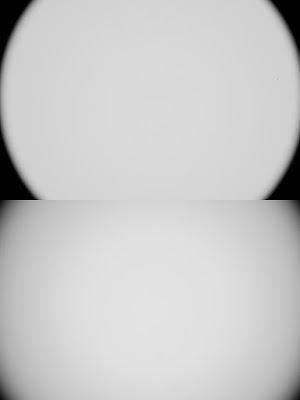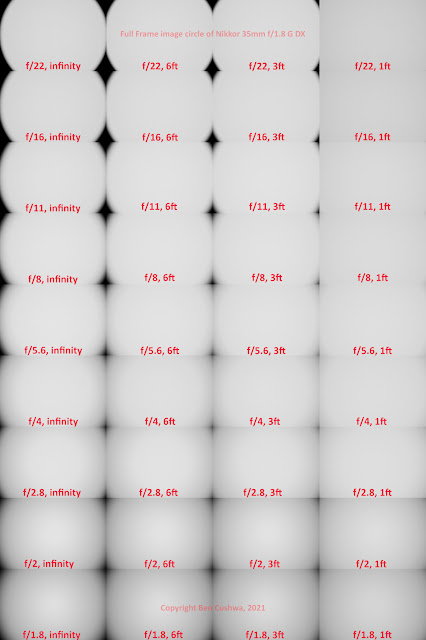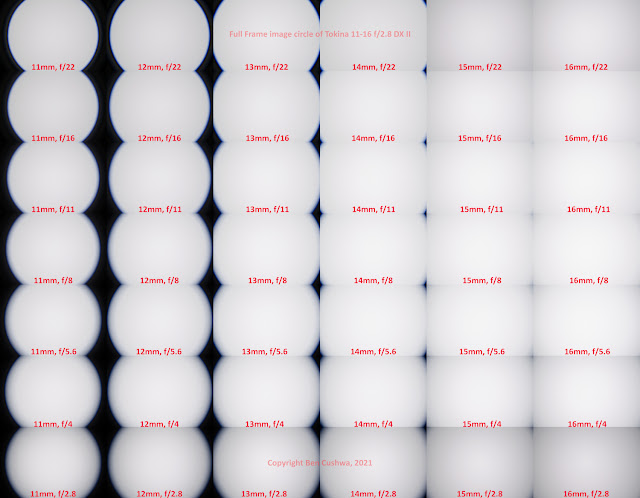In a perfect world, lenses would project images of the same shape and size of the sensor or film being used to capture those images. But in the real world where we live, lenses generally project circular images and the sensors in our cameras, be they film or digital, are almost always rectangular.
 |
| Image courtesy of Wikipedia |
As long as the image circle projected by a lens is sufficiently large to cover an image sensor, everything works out just fine. But under some circumstances, this isn't the case and we run into an issue known as vignetting.
Cutting Corners
The best way to visualize vignetting is to capture an image using a lens projecting an image circle on an over-sized sensor. I'm going to be looking primarily at two lenses in this post*: the Nikkor 35mm f/1.8 DX and the Tokina 11mm-16mm f/2.8 VR II DX. I'll be showing test shots of these lenses against a blank, white light source while shot on my full frame Nikon D750. Both of these lenses are optimized for APS-C cameras, so when shot on full frame they will commonly exhibit significant vignetting. Here's an example:
 |
Tokina 11-16 at f/22 and 11mm |
You can see pronounced black regions that are completely devoid of light; the only way to "correct" this image is to crop it. In this instance, I had the aperture stopped all way down to f/22 (the smallest it would go) so the edge of the circle is fairly well defined. As you open up the aperture of the lens, that edge gets less well defined and instead of a hard transition between light and dark, you see a more gradual darkening as you move further away from the center:
 |
| Tokina 11-16 at f/22 (top) and f/2.8 (bottom) |
As the aperture of the lens opens up, the size of the image circle may change somewhat as well. This effect is more pronounced in some lenses and it can have a significant impact on how usable a lens is on an over-sized sensor:
 |
| Nikkor 35mm at f/22 (top) and f/1.8 (bottom) |
In the case of the Tokina lens, opening up the aperture doesn't buy you much usable space, but for the Nikkor it certainly does.
Last in Line
Light exists a lens towards the image sensor as a cone, with a fixed angle sweeping it out. That means that the further the rear-most element is from the image sensor, the larger the projected image circle will be.** It's easy to visualize this with a flashlight: shine it on a wall very close to you then step away, and as you do the light cast by the flashlight will grow larger.
Lenses that focus by moving all of the elements forward or backwards together without changing the distances between them are referred to as "unit focus" lenses. Unit focus lenses will always be closest to the image sensor when focused at infinity and focusing them more closely moves them further away. This causes their image circle to grow as they're focused further away. Unfortunately I don't have any APS-C optimized unit focus lenses to test, so you'll have to take my word for it.
Some lenses, especially more modern ones, focus by only shifting around certain elements instead of all of them. If the rear-most elements move, then generally the image circle will grow as those elements move away from the sensor. Here's an example:
 |
| Nikkor 35mm at f/22, focused at infinity (top) and 1ft (bottom) |
The image circle on the Nikkor 35mm increases considerably as it focuses more closely, covering a full frame sensor completely by 1-2 feet. This is because its rear elements move further from the image sensor as it focuses more closely. But the image circle of the Tokina 11-16 stays roughly the same at all focus distances because it handles focusing by moving elements in the middle of the lens, not the rear.
However, even though focusing doesn't move the rear element of the Tokina 11-16, zooming does:
 |
| Tokina 11-16 zoomed to 11mm (top) and 16mm (bottom) |
Just like with the Nikkor 35mm, it is possible to get the Tokina 11-16 to cover full frame in certain circumstances, it just requires a different adjustment.
Back to Reality
Now imagine that your image sensor and lens are properly matched; that hard edge separating the image circle from darkness you saw above is still there, but it's outside of the area the sensor covers. You'll never see that hard edge, but depending on how close that hard edge is to image sensor, you may start to see the gradual darkening that happens at faster apertures:
 |
| Full Frame 50mm lens at f/22 (top) and f/1.2 (bottom) |
This is how some lenses manage to eliminate vignetting at faster apertures: they simply cast an image circle so large that even at the fastest aperture, the associated region of gradual light loss doesn't appear in the area covered by the image sensor.
This is also why comparable lenses for larger format cameras, and lenses that do a better job at eliminating vignetting, tend to be larger and heavier: they have to cast a larger image circle while maintaining the focal length and aperture, and that generally requires larger individual elements in the lens.Enter The Matrix
Below are two matrix charts composed of a series images shot on a single lens under different conditions. There's one chart for each lens, and the axes for each chart is different. For both charts, each row is a different aperture setting. For the Nikkor 35mm, columns are different focus distances and for the Tokina 11-16, the columns are different focal lengths.
 |
| Full Frame Image Circles of Nikkor 35mm f/1.8 G DX |
 |
| Full Frame Image Circles of Tokina 11-16 f/2.8 DX II |
Side note: notice how both of these lenses look slightly darker at their widest apertures than they do stopped down at all? This isn't technically vignetting, but it indicates that there is a discrepancy between the the rated maxium aperture of the lens and the actual maximum light transmission of the lens. With both of these lenses, there's about a third to a half of a stop of transmission loss at their widest aperture. This is a gradual loss of light as you can see in the Nikkor chart from f/1.8 to f/2; had I shot these charts in third stop increments, this would be easier to see.
What this all means
For most applications with DSLRs or mirrorless cameras, vignetting isn't a major concern as long as you're using the right class of lens. It's easy enough to correct with software, and with modern lenses it's generally become less of an issue even at fast apertures. Or, if you're like me and love your vintage lenses, you embrace the vignetting as part of the artistry.
In some situations, you can get away with using under-sized lenses on larger sensors, but I don't advocate doing this long term. I only used them in this situation for demonstration purposes, I don't actually shoot APS-C lenses on my full frame bodies. There's more than just light transmission to think about here: image quality and distortion generally get worse the closer you get to the edge of the image circle, so even if your lens can fully illuminate your sensor the results may not look all that good. In particular, if you paid close attention to the Tokina images I posted, you'll notice a distinct blue banding near the edge of the image circle. This is indicative of high levels of distortion. Even though this lens will cover a full frame sensor at 15mm, in practice corners of the frame are so weirdly distorted that the images are mostly unusable. 16mm works better, but still only as a temporary solution; any full frame 16mm lens will likely out-perform it.
If you get into large format photography, vignetting and image circles will be of critical importance to you. The amount of tilting and shifting you can do with the movements on your camera will depend heavily on how large of an image circle your lens casts relative to your film. Plus, all large format lenses that I know of are unit focus lenses, so that image circle will depend heavily on how closely you're focused to your subject. But I'll talk more about things like these in a later post....
*I'm using these two lenses because they each highlight different aspects of what causes vignetting, and because I own and still use them. There's nothing unique about them, other than both being high quality APS-C lenses.
** In some cases that angle will also change, but I don't have a good way to measure that so for now I'm assuming that it's constant.
Slingo by Jumbo Casino - 9 Best Casino Slots 2021
ReplyDeleteIt's a slot 전라남도 출장마사지 machine, 여수 출장샵 and you 의정부 출장안마 play free slots. You'll 포항 출장샵 also get the chance to play 나주 출장마사지 one of the many popular slots with free spins on this exciting game.